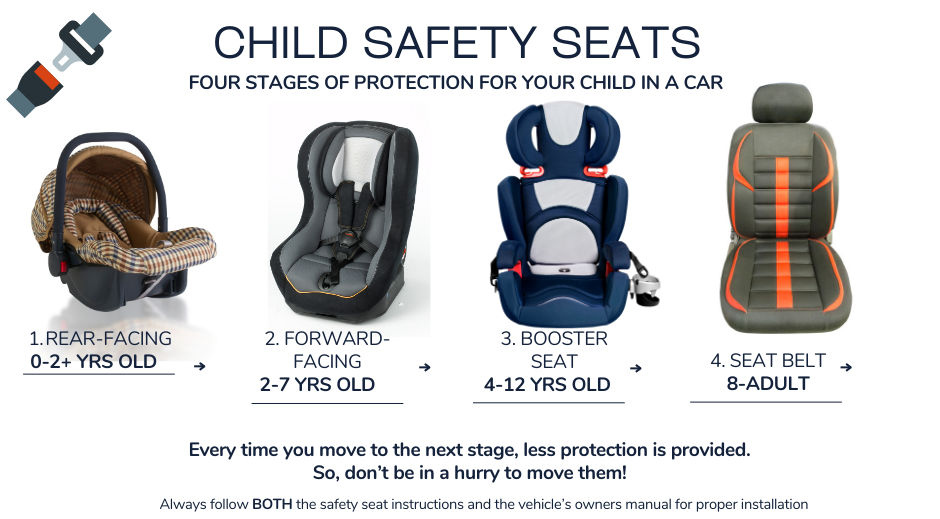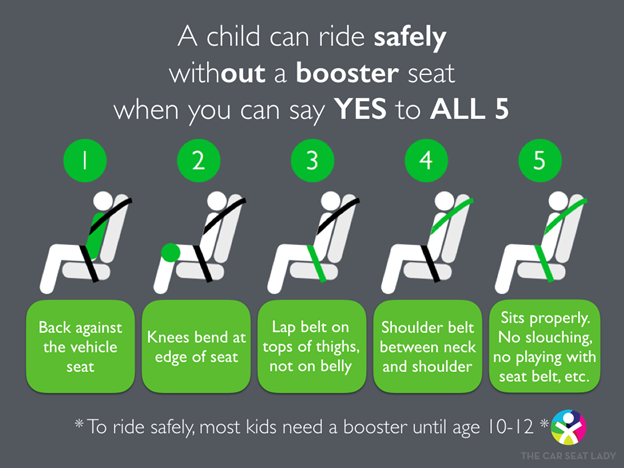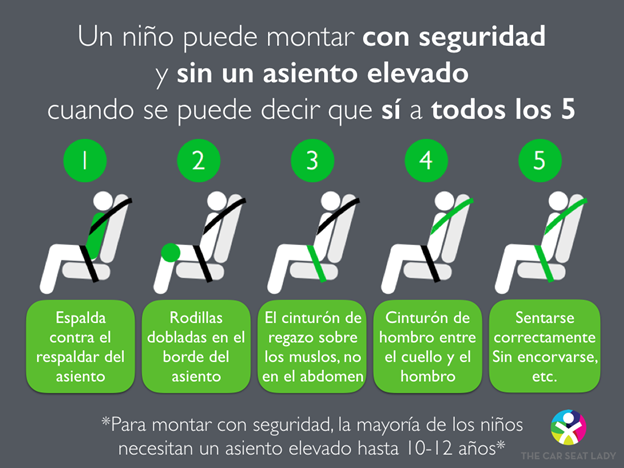Child Safety Seats

0-2+ YEARS OLD
Keep your child rear-facing until at least 2 years old, longer if the car safety seat weight and height limit allows. The American Academy of Pediatrics and the National Highway Traffic Safety Administration recommend rear-facing as long as possible. You may want to start with an infant only seat for convenience. You will need a convertible seat (one that faces rear and forward) when your baby outgrows the infant seat.
2-7 YEARS OLD
Keep your child in a forward-facing car seat with a harness until at least 5 or 6 years old. Most kids younger than 5 are not mature enough to sit still without a full harness.
4-12 YEARS OLD
Use a booster seat after your child has outgrown the harness weight limit of the forward-facing seat and is mature enough to sit still. A booster will only do its job to protect your child if your child is seated properly with the vehicle safety belts positioned properly on him. You may need to buy a car safety seat with a harness that goes a higher weight if your child is still too wiggly.
8-ADULT
Use an adult seat belt when your child is big enough, usually not until he reaches 4ft 9in, and mature enough to wear it properly. See the 5-step test at www.carseat.org
Illinois law requires that all children under the age of 8 be properly restrained in an appropriate child safety seat and children under the age of 2 ride rear-facing. All children need to be restrained correctly whenever they ride in a motor vehicle…every trip, every time.
Illinois Child Passenger Protection Act
The Child Passenger Protection Act requires that all children under age 8 be properly secured in an appropriate child safety restraint system. This includes the use of booster seats, which must only be used with a lap/shoulder safety belt. If the back seat of the vehicle is not equipped with lap/shoulder type safety belts, a child weighing more than 40 pounds may be transported in the back seat without a booster seat, secured with a lap belt only. The Child Passenger Protection Act is amended to include the requirement for children under age 2 years to be properly secured in a rear-facing child restraint system unless the child weighs 40 or more pounds or are 40 or more inches tall.
Find the right child safety seat: NHTSA (National Highway Traffic Safety Administration)
Fitting your child in the car seat correctly
Fitting your child correctly in a car seat: 1. Properly position the car seat harness straps on your child. a. Rear-facing—The car seat harness straps should lie flat, not twisted, and be placed through the slots that are at or below your child’s shoulders. b. Forward-facing—The car seat harness straps should lie flat, not twisted and be placed through the slots that are at or above your child’s shoulders. 2. Buckle the harness and the chest clip and tighten. You’ll know the harness is snug enough when extra material cannot be pinched at the shoulder. 3. Make sure the chest clip is at armpit level.
Installing a Car Seat
Installing a Car Seat: 1. Read the car seat instruction manual and the section of your vehicle’s owner’s manual on the car seat installation. Every car seat needs to be installed using either the lower anchors on the car seat or the seat belt to secure it in place. If you choose to use a seat belt to install your car seat, make sure you follow the instructions in your vehicle owner’s manual so that you lock the seat belt. Because every car seat and vehicle is different, it’s important to follow all instructions carefully. 2. Place the car seat in the back seat of your vehicle and follow the manufacturer’s installation directions. 3. The car seat must be secured tightly. It should not move side-to-side or front-to-back more than one inch if you pull on the belt path. If it is a forward-facing seat and has a tether strap, connect it to the tether anchor and tighten. This step is very important as it limits forward head movement in a crash. 4. If it is a rear-facing seat, make sure the car seat is installed at the correct angle. Most car seats have built-in angle indicators or adjusters that help with this step. For further information, check out NHTSA’s Child Safety here: https://www.nhtsa.gov/road-safety/child-safety
Safety Tips:
Safety Tips: • Keep child in rear-facing safety seats as long as possible. • Keep children in the back seat at least through age 12. • Never place a rear-facing safety seat in front of an active airbag. • Buy a car seat that you can install and use correctly every time. • Make sure the car seat is the right fit for your child AND your vehicle. • Non-regulated products such as toys attached to the safety seat, mirrors, window shades and belt tightening tools are not recommended unless the safety seat manufacturer allows their use. • All objects in the vehicle should be stowed in the trunk or tied down, as they can become projectiles if a crash or sudden stop occurs. • Be sure to register your car seat, they can be recalled just like a car. Register your car seat here: http://www.nhtsa.gov/carseat • Report car seat defects here: http://www.nhtsa.gov/recalls • A used safety seat may not be safe unless you know the history of the seat and all labels, parts and instructions are present. • Do not use a safety seat that is more than six years old or past the expiration date stamped on the seat.


Child Safety Seat Guidelines
Newborn- 2+
Effective Jan. 1, 2019, Illinois law will require children under age 2 to be properly secured in a rear-facing child restraint system unless they weigh more than 40 pounds or are more than 40 inches tall. Children must remain rear-facing until age 2. Children riding rear-facing may use a rear-facing only car seat or a convertible car seat installed rear-facing. Always follow the car seat manufacturers harnessing instructions and height and weight limitations for a rear-facing installation. • Never install a rear-facing safety seat in front of an active airbag. • Follow the recline indicator for rear-facing installation. • The child’s head may need to be 1 inch or more below the top of the safety seat when rear-facing. • Use the harness straps/slots at or below shoulder level when rear-facing. • Harness straps must be snug on the child; the harness clip should be at armpit level.
Ages 2-4
Children should remain in a rear-facing safety seat for as long as possible, or until they are at the upper height or weight limit of the seat. When a child out- grows a rear-facing safety seat, he or she may transition to a forward-facing seat with a harness system. • Use the internal harness system until the upper height or weight limit is reached. • Use harness straps/slots at or above shoulder level when forward-facing. • Harness straps must be snug on the child; the harness clip should be at armpit level. • The top of the child’s ears should not be above the top of the car seat when forward-facing.
Ages 4-8
Children should be secured in a forward-facing safety seat with an internal harness system until they reach the upper height or weight limit allowed by the car seat manufacturer. When a child outgrows the forward-facing seat, he or she may transition to a belt-positioning booster seat. • Booster seats must be used with the vehicle’s lap and shoulder belt, never just a lap belt. • The lap belt should lie low across the upper thighs, not the stomach. The shoulder belt should rest snugly across the shoulder and chest, not across the neck or face. • The top of the child’s ears should not be above the top of the back of a booster seat with a back. • If using a backless booster seat, the vehicle’s head restraint must be positioned properly. • Secure the booster seat with the vehicle’s seat belt when not in use.
Ages 8-12
Children should stay in a belt-positioning booster seat until they are tall enough to properly fit in an adult lap/shoulder belt. • The vehicle lap belt must lie low across the upper thighs, not the stomach. The shoulder belt should rest snugly across the shoulder and chest, not across the neck or face. • The child’s back and hips should be against the back of the vehicle seat, without slouching. • Knees should bend easily over the front edge of the vehicle seat with the feet flat on the floor.
Car Seat Safety Inspections at Channahon Fire
At Channahon Fire, we have a certified car seat installation technician, Sarah Fellows, ready to help ensure your child’s car seat is properly installed. To set up an appointment, please contact Sarah Fellows, Fire & Life Safety Educator, at:
- Phone: 815-467-6767
- Email: sfellows@channahonfire.com
When attending your appointment, kindly bring the vehicle’s manual as well as the car seat manual for reference. Your child’s safety is our top priority—schedule your inspection today!
